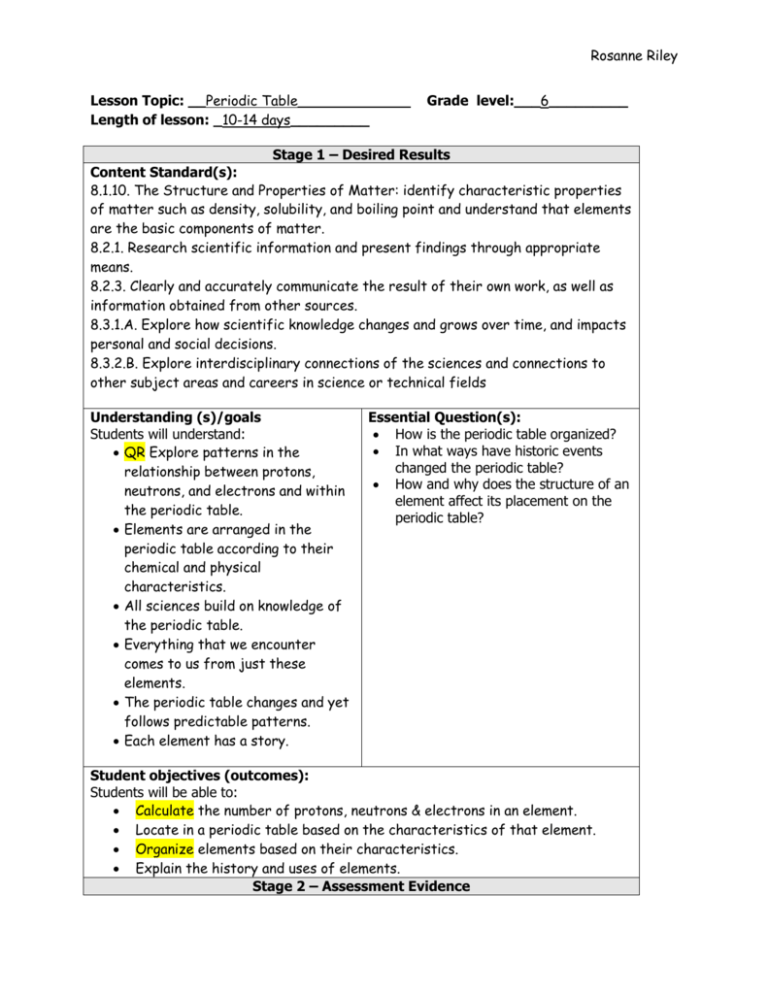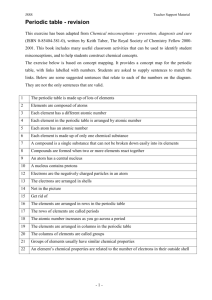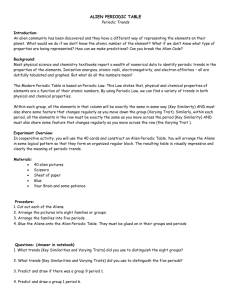
Rosanne Riley
Lesson Topic: __Periodic Table_______________
Length of lesson: _10-14 days_________
Grade level:___6_________
Stage 1 – Desired Results
Content Standard(s):
8.1.10. The Structure and Properties of Matter: identify characteristic properties
of matter such as density, solubility, and boiling point and understand that elements
are the basic components of matter.
8.2.1. Research scientific information and present findings through appropriate
means.
8.2.3. Clearly and accurately communicate the result of their own work, as well as
information obtained from other sources.
8.3.1.A. Explore how scientific knowledge changes and grows over time, and impacts
personal and social decisions.
8.3.2.B. Explore interdisciplinary connections of the sciences and connections to
other subject areas and careers in science or technical fields
Understanding (s)/goals
Students will understand:
QR Explore patterns in the
relationship between protons,
neutrons, and electrons and within
the periodic table.
Elements are arranged in the
periodic table according to their
chemical and physical
characteristics.
All sciences build on knowledge of
the periodic table.
Everything that we encounter
comes to us from just these
elements.
The periodic table changes and yet
follows predictable patterns.
Each element has a story.
Essential Question(s):
How is the periodic table organized?
In what ways have historic events
changed the periodic table?
How and why does the structure of an
element affect its placement on the
periodic table?
Student objectives (outcomes):
Students will be able to:
Calculate the number of protons, neutrons & electrons in an element.
Locate in a periodic table based on the characteristics of that element.
Organize elements based on their characteristics.
Explain the history and uses of elements.
Stage 2 – Assessment Evidence
Rosanne Riley
Performance Task(s):
1) Create a tile for the periodic table
incorporating traditional
information as well as historical
information about its discovery and
how it is used.
2) You have been contacted by a local
publishing company and asked to
write a “biography” for your
element for inclusion in a children’s
book. Your will create a biography
of no more than two pages with at
least one illustration. Your pages
should focus on the historical
background and impact the
element has on the world today.
You should also include an in-depth
description of its physical
characteristics.
3) You are a scientist who has
discovered fragments of a periodic
table from another planet along
with clues to the elements
placement. Your job is to use the
clues correctly place the elements
on the periodic table and then
relate them to elements with the
same characteristics in the periodic
table used on Earth.
Other Evidence:
Informal check of understanding of
period, group, family, reactivity,
lanthanides, actinides and synthetic
elements using the large periodic table.
(moving on the large table students
have constructed from their tiles in
Performance Task 1)
Tests & quizzes (from Prentice Hall
Physical Science Review &
Reinforcement Worksheets)
1) Introduction to Atoms
2) Organizing the Elements
Models of electron configuration for
elements in periods 2 & 3.
Exit card- What did you learn from
researching your element and creating
the tile?
Exit card- Draw an electron
configuration diagram for Oxygen.
Exit card- Name the element in period
2 group 13?
Exit card-If you were to design a tile
again what would you do differently?
Stage 3 – Learning Plan
Learning Activities:
Periodic Table Pre-Assessment
Music in background as students enter the classroom: Little Boxes
A. Show several periodic tables including at least one that is older and have students
look at them and discuss and note the similarities & differences in them (small group).
What might explain the differences? Jot ideas in science notebook
Hook: Bring in a variety of objects; helium balloon (He), magnesium fire starter rods
(Mg), charcoal (C), neon light (Ne), chunk of iron (Fe) and ask where they belong on
the table?
Read relevant sections from textbook-(Organizing the Elements)
B. Discuss how models are used to show electron configuration.
Read relevant sections from textbook-Introduction to Atoms and discuss the
contributions of Democritus, Dalton, Thompson, Rutherford, Bohr and Chadwick.
Rosanne Riley
Have each table group select one of the scientists and create a small poster with their
picture the date of their significant contribution and list their contribution. Save these for
the time line activity.
Use formulas to calculate the number of protons, neutrons, and electrons in an element.
Students should work in pairs to make a model of elements in periods 2 & 3 showing the
levels and electrons in each level. Each pair should do two elements on from each
period each on a separate sheet of paper. Element name should be at upper center of
sheet. Protons, neutrons, and electrons should be different colors of paper dots. A key
should be placed in the lower right corner.
When models are finished they should be lain out on the floor in the order they would
be found in the periodic table.
One minute essay: Explain any patterns you observed as you created your models
and placed them on the floor with others models?
C. Allow students to select an element they would like to research and assign two
additional elements (try to get a variety for each student so they are working with
different periods, groups or families of elements). Give students a copy of the tile
template (see end of plan) Template should be on 8.5” square of paper.
Students should then research each element and construct their tiles. Tiles should be
made on colored paper to match the main text being used. Different colors for different
groups of elements i.e metals, metalloids, non metals.
(Students may make additional tiles for extra credit so your periodic table is complete)
Teacher prep for large periodic table: 8.5 X 8.5 inch squares of paper in colors to match
periodic table in text
plastic sheeting (Available in large rolls at Ace Hardware) 20 squares across to allow room on the
end =170 inches
10 squares down to allow 7 periods down plus 2 series=85 inches
D. Once tiles are completed give each student a clothespin and stretch a string across
the classroom. Have students form a timeline of the elements by pinning their element
to the timeline in the appropriate location for its discovery date. Add the posters about
each scientist from activity B above.
Reflective Journal: Record observations about the timeline. What did you discover as
you looked at the timeline? What are the big ideas that the timeline conveys? What
surprised you?
E. Assemble periodic table on plastic sheeting using clear packing tape. It is helpful to
place one vertical line and one horizontal line on the plastic to act as a guide for your
first tiles. You will be placing the tiles on the back of the plastic so that it can be walked
on when finished. Only a few students can tape at a time. The remainder can be
working on the biography component. When table is completed it can be used to test
students on vocabulary and concepts.
Bring back the objects from activity A and have students place them on the large table.
Exit card-If you were to design a tile again what would you do differently?
F. Write biography of element, (Inspiration™ diagram to for items to be included)
remember to leave space for your original drawings on the final copy page. Students
Rosanne Riley
should use peer editors prior to preparing final copy.
Students who finish early can help with preparing opening pages or covers for the
book which will be made from the biographies using Written & Illustrated By format.
Self evaluation: How does what you’ve learned relate to the present and the future?
G. Alien Periodic Table Activity
Rosanne Riley
Periodic Table Pre-Assessment
1. What are some elements that you are familiar with?
2. What is the periodic table?
3. How was the periodic table developed
4. If a new element were discovered, how would a person know where to put it on the
table?
Rosanne Riley
##
Atomic Number
Rr
Who discovered
(Picture and words)
Chemical symbol
When discovered?
Uses (pictures
and words)
Atomic Weight
(Tile Template)
Name
Rosanne Riley
Tile rubric
Outstanding
Information is
complete and
multiple uses are
given.
Format is followed
and presentation is
flawless.
Successful
Alien Periodic Table
Alien
Identification
Expert
All elements are
correctly placed
Elements are all
correctly matched
with Earth’s
elements
Major remodeling
needed
Major pieces of
information are
missing.
All information is
present and
accurate.
Minor information is
missing.
Format is followed.
Minor details detract
from presentation.
Looks more like a
draft than a final
copy
Apprentice
Relationship and
key ideas are fuzzy
and incomplete.
Thesis is present
but support is
lacking.
Amateur
Key ideas and
relationships are not
addressed.
Mediocre
Reads like an
encyclopedia entry
rather than a story.
Facts are present
but not completely
accurate.
Illustrations are
present but it is not
clear how they
relate to the story.
Limited
Looks more like
notes than a story.
Reflection & Self-Evaluation rubric
Master
Journeyman
Writing
Topic is adequately
demonstrates depth addressed. Support
of understanding of is present but not as
relationships and
well developed as a
key ideas. Strong
master would
thesis and support.
develop the topic.
Biography rubric
High quality
Writing is engaging,
facts are presented
in an interesting
manner. Draws
reader in. Has a
definite personality
Illustrations are well
done and add
interest to the story.
Almost there
Average
Moments of
engagement
however, voice is
limited.
Facts are present
and accurate.
Illustrations are
present and well
done.
Scientific thinker
Two or fewer
elements out of
place
Minor mistakes on
matching.
Lab assistant
Limited or nonexistent
illustrations.
What planet?
Several elements
out of place
Few elements
placed correctly.
Several mistakes on
matching
Did you forget to
match elements?
Rosanne Riley
Writing Your Element's Biography
Steps for writing your element's biography
Remember, this is to be written in more of a story format, with accurate scientific details.
I. Which element is this story about?
A. Where was it discovered?
B. Who discovered it?
C. What were the events occurring when this element was discovered?
This is the historical aspect of your element's life?
II. What family does the element belong to?
A. What are the characteristic properties of this element?
B. Where will it be found on the periodic table?
III. What is this element's purpose?
A. What are its uses?
IV. Interesting facts about the element.
A. How should this element be handled?
B. What are the most interesting things you found out about this element?
Rosanne Riley
Alien Periodic Table
You are a scientist who has discovered the following fragments of a periodic table from another
planet along with clues to the elements placement. Your job is to use the clues correctly place
the elements on the periodic table and then relate them to elements with the same
characteristics in the periodic table used on Earth.
Directions
Use the following clues and your knowledge of the periodic table from our planet to arrange the
elements correctly on the periodic table above. You may need to skip a clue and come back to
it later in order to complete the task. Directions for the rest of the task can be found after the
clues. You may use a copy of the periodic table we use in class. You may also color the squares
if that helps.
Rosanne Riley
Clues:
The noble gases are bombaI (Bo), wobble (Wo), jeptum (G), and logon (L). Among these
gases, wobble has the greatest atomic mass and bombal the least. Logon is lighter than
jeptum.
The most reactive group of metals are xtaIt (X), byyou (By), chow (Ch), and quackzil (Q).
Of these metals, chow has the lowest atomic mass. Quackzil is in the same period as
wobble.
Apstrom (A), vulcania (V), and kratt (Kt) are nonmetals whose atoms typically gain or
share one electron. Vulcania is in the same period as quackzil and wobble.
The metalloids are ernst (E), highho (Hi), terriblum (T), and sississ (Ss). Sississ is the
metalloid with the greatest atomic mass. Ernst is the metalloid with the lowesatomic mass.
Highho and terriblum are in Group 14. Terriblum has more protons than highho. Yazzer
(Yz) touches the zigzag line, but it's a metal, not a metalloid.
The lightest element of all is called pfsst (Pf). The heaviest element in the group of 30
elements is eldorado (El). The most chemically active nonmetal is apstrom. Kratt reacts with
byyou to form table salt.
The element doggone (0) has only 4 protons in its atoms.
Floxxit (Fx) is important in the chemistry of life. It forms compounds made of long chains of
atoms. Rhaatrap (R) and doadeer (Do) are metals in the fourth period, but rhaatrap is less
reactive than doadeer.
Magnificon (M), goldy (G), and sississ are all members of Group 15.
Goldy has fewer total electrons than magnificon.
Urrp (Up), oz (Oz) and nuutye (Nu) all gain 2 electrons when they react. Nuutye is found as
a diatomic molecule and has the same properties as a gas found in Earth's atmosphere. Oz has
a lower atomic number than urrp.
The element anatom (An) has atoms with a total of 49 electrons.
Zapper (Z) and pie (Pi) lose two electrons when they react. Zapper is used to make
lightweight alloys.
Rosanne Riley
Directions: Using your completed alien periodic table list the alien elements and their
corresponding earth elements on the following table in order of atomic number
Alien element
Earth element
Rosanne Riley
Alien element
Earth element
Explain why you could use clues about atomic mass to place elements even though the table
was based on atomic numbers?
Rosanne Riley
Alien Periodic Table Key
You are a scientist who has discovered the following fragments of a periodic table from another
planet along with clues to the elements placement. Your job is to use the clues correctly place
the elements on the periodic table and then relate them to elements with the same
characteristics in the periodic table used on Earth.
Directions
Use the following clues and your knowledge of the periodic table from our planet to arrange the
elements correctly on the periodic table above. You may need to skip a clue and come back to
it later in order to complete the task. Directions for the rest of the task can be found after the
clues. YouPfmay use a copy of the periodic table we use in class. You may also color the squares
Bo
if that helps.
Ch
O
E
Fx
G
Nu
A
L
By
Z
Yz
Hi
M
Oz
Kt
G
Q
Do
R
T
Ss
Up
V
Wo
X
Pi
An
El
Rosanne Riley
Directions: Using your completed alien periodic table list the alien elements and their
corresponding earth elements on the following table in order of atomic number
Alien element
Pfsst
Earth element
Hydrogen
Bombal
Helium
Chow
Lithium
Doggone
Beryllium
Ernsst
Boron
Floxxit
Carbon
Goldy
Nitrogen
Nuutye
Oxygen
Apstrom
Fluorine
Logon
Neon
Byyou
Sodium
Zapper
Magnesium
Highho
Silicon
Magnificon
Phosphorus
Oz
Sulfur
Kratt
Chlorine
Rosanne Riley
Alien element
Quackzil
Earth element
Potassium
Doadeer
Calcium
Rhaatrap
Gallium
Terriblum
Germanium
Sississ
Arsenic
Urrp
Selenium
Vulcania
Bromine
Wobble
Krypton
Xtalt
Rubidium
Pie
Strontium
Anatom
Indium
Eldorado
Tin
Explain why you could use clues about atomic mass to place elements even though the table
was based on atomic numbers?
The atomic mass usually increases as the atomic number increases.
Rosanne Riley
Elements and the Periodic Table • Quiz
Introduction to Atoms
Label each model of the atom with the name of the scientist who developed it.
1.
2.
3.
4.
Building Vocabulary
Match each term with its definition by writing the letter of the correct definition on the
line beside the term in the left column.
5. nucleus
6. proton
a.
7. neutron
b.
8. electron
9. atomic number
c.
d.
10. isotopes
11. mass number
e.
a. the sum of protons and neutrons in the nucleus of
an atom
b. the very small center core of an atom
c. atoms of the same element that differ in the
number of neutrons, but have the same number of
protons
d. the particle of an atom that moves rapidly in the
space outside the nucleus
e. a specific amount of energy related to the
movement of electrons in atoms
12. energy level
f.
g.
f. the particle of an atom with a positive charge
g. the number of protons in the nucleus of every atom
of an element
h. the particle of an atom that is neutral
© Peorson Education, Inc, publishing os Peorson Prentice Holl. All rights reserved.
Rosanne Riley
Organizing the Elements Quiz
Understanding Main Ideas
The diagram below is a square from the periodic table. Label the four facts shown about each element.
47
1.
2.
Ag
Silver
107.8 3.
107.8
3.
4.
Answer the following questions in the spaces provided.
5. In what order did Mendeleev arrange the elements in the periodic table? ___________________________
_____________________________________________________________________________________
6. What do elements in the same column in the periodic table have in common?
7. What can you predict about an element from its position in the periodic table?
Building Vocabulary
From the list below, choose the term that best completes each sentence.
atomic mass
period
chemical symbol
plasma
group
periodic table
8. An element's
nuclear fusion
is its row in the periodic table.
9. Mendeleev was the first to arrange elements in a(n)
10. Elements in a(n)
11. A(n)
based pm their properties.
, or family, of the periodic table have similar qualities.
is an abbreviation for the name of an element and has one to three
letters.
12. The
element.
of an element is the average mass of all the isotopes of that






